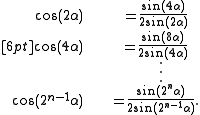
Morrie's law
Encyclopedia
Morrie's law is a name that occasionally is used for the trigonometric identity

It is a special case of the more general identity

with n = 3 and α = 20°. The name is due to the physicist Richard Feynman
, who used to refer to the identity under that name. Feynman picked that name because he learned it during his childhood from a boy with the name Morrie Jacobs and afterwards remembered it for all of his life.
A similar identity for the sine function also holds:

Moreover, dividing the second identity by the first, the following identity is evident:


Solve for

It follows that

Multiplying all of these expressions together yields:

The intermediate numerators and denominators cancel leaving only the first denominator, a power of 2 and the final numerator. Note that there are n terms in both sides of the expression. Thus,

which is equivalent to the generalization of Morrie's law.

It is a special case of the more general identity

with n = 3 and α = 20°. The name is due to the physicist Richard Feynman
Richard Feynman
Richard Phillips Feynman was an American physicist known for his work in the path integral formulation of quantum mechanics, the theory of quantum electrodynamics and the physics of the superfluidity of supercooled liquid helium, as well as in particle physics...
, who used to refer to the identity under that name. Feynman picked that name because he learned it during his childhood from a boy with the name Morrie Jacobs and afterwards remembered it for all of his life.
A similar identity for the sine function also holds:

Moreover, dividing the second identity by the first, the following identity is evident:

Proof
Recall the double angle formula for the sine function
Solve for


It follows that

Multiplying all of these expressions together yields:

The intermediate numerators and denominators cancel leaving only the first denominator, a power of 2 and the final numerator. Note that there are n terms in both sides of the expression. Thus,

which is equivalent to the generalization of Morrie's law.

